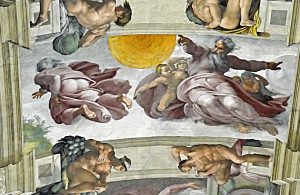Our host for a recent meeting in Rome was a member of the distinguished Italian family that produced Pope Martin V. Because of his connections and likely his generosity, he was able to arrange a private tour of the Vatican Museums, ending at the Sistine Chapel. Allowed to wander freely, taking as many pictures and asking as many questions as we wanted, we saw both the familiar and the mildly shocking.
Michelangelo’s frescoes are magnificent, whether hurrying through or lingering, all the more so since their colors were restored to their original brilliance. His most famous scene, in the center of the Sistine Chapel ceiling, shows God almost touching the finger of Adam. In 1990 F. Lynn Meshberger, who now practices medicine in Anderson, provided an alternative to the traditional explanation that God is giving life to Adam. While a medical student at I.U., he published an article demonstrating that God’s cape and various protruding appendages closely mimic the shape and structures of the human brain. He suggested that Michelangelo, who studied human anatomy, may have intended to show God giving Adam the gift of intelligence. That story, without the student’s name, is routinely told by Sistine Chapel guides. I learned Dr. Meshberger’s name when, to my utter astonishment, he was in the audience of a presentation I was giving about images of God that included his idea and he identified himself afterward. I have been glad ever since that I stuck pretty close to the facts of his story.
Near the end of our visit, my wife noticed a ceiling scene that was not called out by our guide. A panel over the altar, showing God creating the sun and the moon, includes what can most delicately be described as a strategically undraped and provocatively directed male derriere, apparently that of God. Some speculate that this unusual scene was Michelangelo’s way of insulting Pope Julius II for making him spend four years in agony painting frescoes when he wanted instead to be a sculptor. If so, one wonders if the Pope ever got the point. Others piously suggest Michelangelo was illustrating that people are not supposed to see the face of God, a theory that seems a stretch because God’s face is shown in the same panel. Or perhaps there is no message – the Sistine Chapel ceiling shows a lot of uncovered flesh reflecting only Michelangelo’s virtuosity. Whatever its raison d’être, Michelangelo’s moon reflects an eternal truth – the greater the artist, the greater the mystery.

Comments are closed.